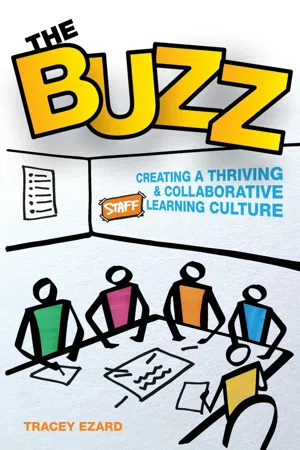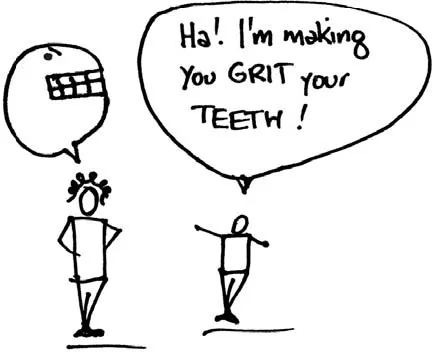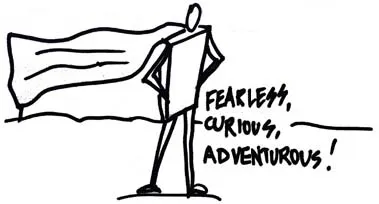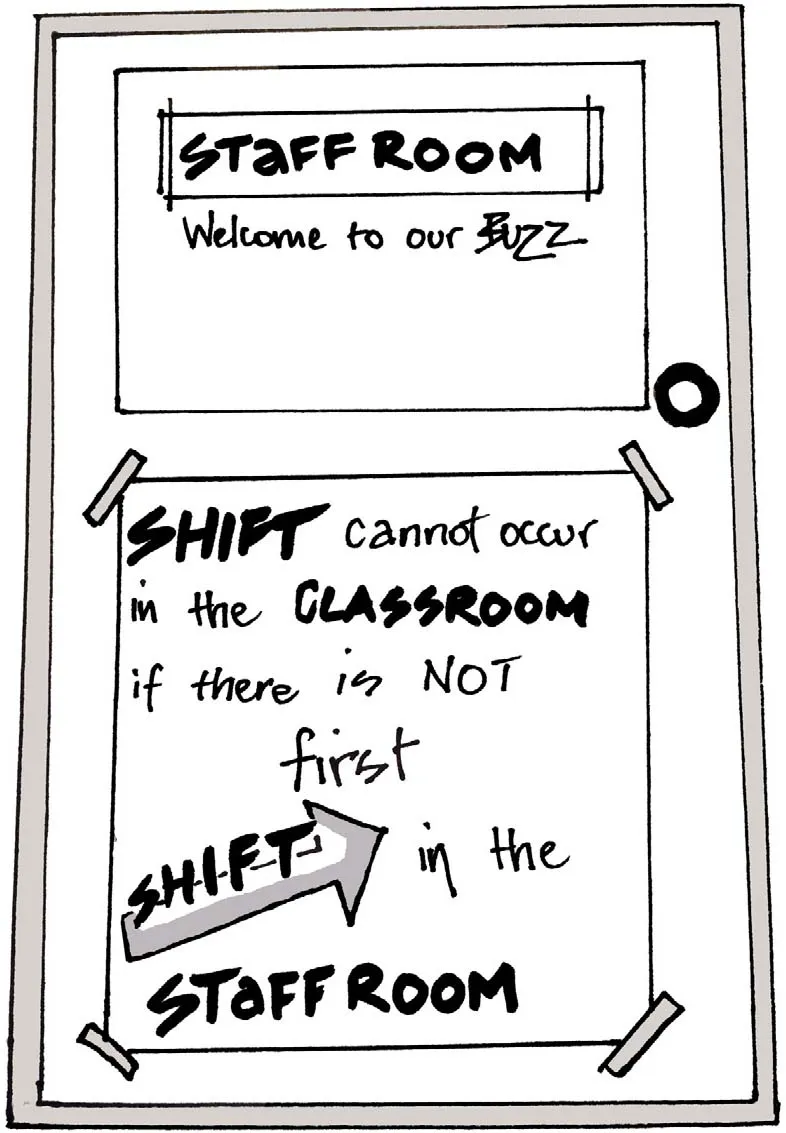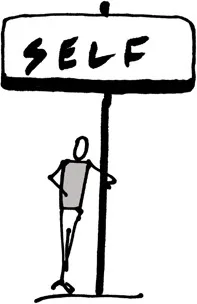![]()
1. WHAT’S THE BUZZ?
LEARNING INTELLIGENCE a.k.a THE BUZZ
Ever been in a situation that changed the way you see the world? It may not have seemed profound at the time, but upon reflection it urged a real shift in your thinking.
When I was in my third year of teaching, I met Steven. He was a smart, savvy and cheeky Year 5 student. He was clever, but found school boring and constricting. Teachers were the bane of his life and he showed it by acting up in all sorts of ways. He knew every teacher’s ‘hot buttons’ and didn’t hesitate to use them when he felt like it. I didn’t teach Steven directly, but had him in some small-group work for various activities, such as gifted and talented programs or musical productions. Usually I loved him. He was the type of kid who was suggesting, ‘Stay on your toes – I’m worth the hard work getting through to me. If you do, I’ll give you all I’ve got’. So he and I had a pretty good relationship. I loved the way he thought and his push-the-boundaries attitude.
One day, though, his usual button-pushing got the better of me. He looked at me and said with delight: ‘I’m making you grit your teeth’. And he was right, the little so and so! He knew, before I was consciously aware, that I was reacting to him in a less-than-useful way.
That day I switched on to the need to be more in tune to my resourcefulness and learn better ways to manage myself when stressed, tired or overwhelmed. Not only that, it set me on a road to find out more about emotional intelligence and skills that make us more emotionally aware of ourselves and others. It’s okay just to learn something – just gain the information and say, ‘Yes I know that’ but I wanted to live the learning. Really test it, play with it, embed it.
I’m happy to say that I am still playing with the same essential question: How can we be our most resourceful in our work? How can we be in a state that always brings the best of ourselves to the situation with enough resources at our disposal?
Every day I’m learning more and more about that through reading, professional learning, listening to experts, looking at theories. I make sure I hang out with people who stretch my thinking and encourage me to grow. Best of all I get to learn from the people I work with every day. They are constantly giving me new ideas and approaches to try. Some (many) of the ideas fail. That’s okay because failing is part of learning and I know that learning intelligence, the ability to apply, synthesise, evaluate, discard or embed, is a growing intelligence. It’s never static. Learning intelligence helps me to be an agile and adaptive learner
The most important element of learning intelligence is the mindset of curiosity and growth. Even in the darkest of environments and the darkest conversations, someone with a strong sense of learning intelligence can pull themselves out with a good dose of ‘I wonder’. They see possibility. They ask ‘what if?’.
To start my business working in developing leaders, I drew on my experience in teaching and in leadership positions in education and business as well as my areas of study. The main focus of my work was in developing emotional intelligence, resourcefulness and wellbeing.
Pivotal to high emotional intelligence is understanding the mindset, values and beliefs that drive behaviour. These beliefs shape who we are as individuals and as team players and collaborators.
After a number of years it became increasingly important for me to connect the work I was doing with a school’s or organisation’s leaders with the strategic direction of that school or organisation. No longer did it seem feasible to work with leaders on growing themselves and their teams without a strong link to what they were doing and where they were going.
As soon as I branched out into the strategy area something else became very evident. Schools with a thriving professional learning community – with a buzz – were able to collaborate on their strategic work much more effectively. People took responsibility and accountability for their part of the work and for their own learning. They could have robust debate about what needed to happen to get the student outcomes they were after, and they put together plans to make it happen. More and more I began to see that not only do we need to build our ability to emotionally manage ourselves and others (emotional intelligence) and our strategic thinking, but we also need to build our ability to learn as adults in a fearless, curious and adventurous way.
Working with many school leaders and teachers over the past 10 years I have observed that leaders who get the most traction are those who are voracious learners themselves. Not just academic learning, but deeply embedded, tested, trialed, reflective learning from experiences.
The application of learning and reflection on our own performance as adults is always fraught with danger. We have deeply embedded beliefs and assumptions about our skills, capabilities and limitations — our thoughts about right and wrong and whether something fits our view of the world. Couple this with fear of failure, over-use of comparison and occasional power issues and the outlook can be bleak. Yet deep personal learning and growth as an educator and professional can also be one of the most transformative and satisfying journeys.
Optimism and possibility, risks and possible failures, are part of the journey.
In schools our own learning is pivotal to the success of the students. If educators do not see learning as a personal cornerstone of their work, then why should anyone else? The development of a school’s professional learning environment is a key element of any thriving school’s culture.
Collective wisdom and building collective capacity are the way of the future. We need to be creating this within our staff learning community or the future will pass us by.
Getting a good sense of how strong our buzz is (is it a buzz, just a hum or are those just crickets chirping?) can be a challenge when you’re sitting in the middle of it. To gauge what is going on we need to sit back and reflect on ourselves and the school. The metaphor of the balcony and the dance floor, coined by Ronald Heifetz and Marty Linsky in Leadership on the Line, is a useful mindset to apply here.
The balcony and dance floor refers to the ability to look at the situation, organisation and interaction from a balcony view, where we can make more objective evaluation and analysis of what is going on and what is needed. When we are down on the dance floor, we can be swamped with day-to-day tasks and not see past our noses.
The balcony can be used in a very strategic way to ask: Where are our challenges and strengths? Where are we headed? What are our strategies? It can be used in a very personal, reflective way: If I replay that conversation or that meeting from a balcony viewpoint, what can I learn from it? Can I gain more insight into what occurred? Do I see another way I might have addressed the situation? The balcony can also be used as a metaphoric pause, when you stop momentarily to work out your next step, based on a different perspective from the present moment.
As you read this book I encourage you to use the ideas put forward as a lens through which to look at the dance floor of your learning culture. Make sure you get good objective data about what is really happening and don’t make plans that are only informed by a distant balcony view. While the balcony view offers an important perspective, be careful not to make plans that are only informed by this view. To find out what is really occurring, talk with the people involved and understand their perspectives and drivers. Be pragmatic and inspirational about co-creating the thriving and collaborative culture you’re after. Schools that buzz with that kind of culture have learning intelligence.
Learning intelligence needs to be evident at three levels for a school to create a truly thriving professional learning culture. These three levels are like the layers of an onion. In the centre is the individual, the strength of learning intelligence in each individual member affects the quality of the outer layers. The middle layer represents all the teams within the school structure and the way they work together. The outer layer is the school unit as a complete, thriving learning organisation. If one of these levels is not pulling its weight with regard to learning, the outcomes are not as strong, which can lead to frustration for many.
Of course each school is also a part of a greater system, which can be viewed as a wider learning community. Schools can contribute to this community by linking and learning with other schools. Some innovative and clever schools go further by linking with other parts of the system, such as human services, health professionals and the justice system to create a more effective whole that can provide greater integration to deal with ‘wicked’ problems like mental health issues, generational poverty, domestic violence, and drug and alcohol issues. Wicked problems refer to problems that are hard to define. There are usually incomplete or contradictory parts to the problem, many changing contexts and requirements. Because the problem ‘belongs’ to more than one agency, it’s often not dealt with correctly or thoroughly. It can be too easily either brushed aside or the responsibility shifts from one group to another without traction.
Even though this system thinking requires schools to look outside themselves to produce change, the ability to create a thriving learning environment and culture within is still the first step.
The Learning Intelligent Self
History was made in November 2014 when, after a 10-year, six-billion-kilometre journey, the Philae lander was rocketed from the Rosetta spacecraft and landed on a spinning comet hurtling through space at 18 kilometres per second.
While it’s hard for our brains to comprehend the numbers, how amazing to think of the constant feedback and adaption required leading up to that bouncing landing. The evolution in technology since Rosetta was initially launched in February 2004 boggles the mind. Imagine the forethought scientists had to create something so far into the future that can still be responsive and adapt to a huge amount of unforeseen scenarios in space, as well as changing technology on Earth. Not only that, but because of the huge distance from Earth, communication from Rosetta to the controllers was 28 minutes behind real time!
Learning intelligence is like this mission – crucial information and insights are around us all the time to learn from and adapt or reinforce our approach. We need to be agile and responsive to do this adaption.
As educators our main subjects are human beings – constantly evolving, endlessly changing, learning, responding and growing – so if our approach does not contain these same elements we are going to miss the comet landing every time.
In his study ‘Visible Learning’ Professor John Hattie researched the things teachers do that have the most effect on learning. Not surprisingly, he found that feedback had a high level of influence. According to Hattie the most powerful feedback is that given from the student to the teacher. It makes learning visible and allows the agile teacher to plan the next steps. Educators who respond to the feedback they receive from learners about whether they are actually learning and use that feedback to inform future learning and teaching strategies are increasing the opportunity for student success. To be able to take on this feedback and access it in a deep and meaningful way, we must be in a learning mode ourselves – open, growth orientated and comfortable with an agile approach. We also need to be happy with not being right all the time. Then we are using our learning intelligence.
Hattie’s book, Making Learning Visible, is a valuable resource for focusing teachers on being responsive to feedback and for understanding the factors that can make the biggest impact on learning. This feedback creates a strong second-position opportunity, that is: I see learning not from my eyes, but from the eyes of my students. When we are firmly in ‘first’ position (or ‘I’) we have a tendency to only see feedback from our own perspective.
My daughter’s friend gave me a great example of this when we were talking about her language classes. She is in primary school and has a 50-minute language session each week. Her comment was: ‘We just get started on something and then the very next session we are on to something else – I feel like I don’t really get a chance to learn it properly before we’ve moved on.’ Even though this is a broad comment, it gives an interesting view of perspective from a student voice.
Great professional learners have a deep-seated drive to bring the best of themselves to school each day. Every ti...
